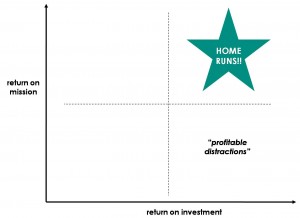strategic alignment, the zoo way
Last week I had the pleasure of hearing the Director of Vision, Innovation, & Strategy for the San Diego Zoo,  Beth Branning, speak about “Implementing Organization-Wide Strategic Alignment.” The story of her efforts to drive through the organization the Zoo’s 5-year strategic plan provides some valuable insights and takeaways.
Beth Branning, speak about “Implementing Organization-Wide Strategic Alignment.” The story of her efforts to drive through the organization the Zoo’s 5-year strategic plan provides some valuable insights and takeaways.
In addition to the difficulties inherent in strategy implementation, Beth faces some unique challenges:
- The Zoo (actually the Zoological Society of San Diego, which runs the world famous San Diego Zoo, along with the Wild Animal Park and the Institute for Conservation Research) is a non-profit organization. As a result, their payroll budget is limited and so they aren’t able to use monetary compensation as an incentive for employee cooperation. And most employees are lifers (that is, they stay in their jobs until retirement), so upward mobility in the organization is also limited. Therefore they can’t rely on the usual methods for motivating and rewarding employees for adopting the strategic plan.
- Another implication of having employees with a long employment history with the organization is that many of them are quite skeptical of management initiatives like strategic plans. They’ve seen more than their share of organizational changes that have come and gone without gaining traction – so they’re not likely to readily embrace a new strategic plan.
- The Zoo also has an active Board of Trustees. Unlike a typical non-profit board of directors, whose primary role is to support the organization financially, the Zoo’s board has been actively involved in the management of the organization. Although Beth has no official authority over this additional group of stakeholders, she has to gain their support for and cooperation in implementing the strategic plan.
Some of the tactics Beth has deployed have successfully overcome these challenges:
– Organization: They’ve created an implementation architecture in which organizationally-representative teams own every aspect of the strategic plan. For example, one part of the plan focuses on Identity (“transforming the identity of the Zoo into the global conservation leader by raising awareness of our conservation work, actively pursuing open strategic partnerships, and becoming catalysts for change.”) So, a team of employees and managers from different areas of the company, along with selected board members, is responsible for the implementation of the Identity plan.
They’ve also designated “STAT” teams – Strategic Action Teams – that convene with express purpose of removing implementation roadblocks. STATs only meet when issues arise and their decisions are final. As such, the combination of the organizationally-representative teams and the STATs ensures implementation is operationally feasible and facilitates organization-wide buy-in, while offsetting potential inertia by establishing clear decision-making protocol.
– Planning Framework: The teams apply a planning framework in evaluating if existing programs and activities should continue and if new ones should be introduced. The framework incorporates a view of ROI (Return on Investment) and ROM (Return on Mission) and aims for all programs and activities to be classified as “home runs” (high ROI and high ROM.)

This framework has led them to identify quite a few things that are “profitable distractions” – those programs or activities that generate a lot of revenue but aren’t aligned with the Zoo’s vision and values. Instead of simply shutting these down, however, they work on converting them into “home runs” by exploring how they could be modified in order to generate a higher ROM. For example, a popular feature at the Wild Animal Park used to incorporate a Sponge Bob Square Pants video. By switching the video out for a dynamic safari-themed one, they were able to maintain guest interest in the feature and improve its mission alignment.
– Communication: Beth explained they have packaged the strategic plan into different formats that make it accessible and usable for different stakeholder groups. They named the plan “Lynx” (after the species of wildcat) and created a tool called “Pocket Lynx.” It’s a business card-sized primer on the basic tenets of the plan for all employees to carry with them and refer to regularly. So widespread has the adoption of this tool been, Beth encouraged us to ask a Zoo employee on our next visit there about Lynx and to see whether or not they could show us their Pocket Lynx!
They also hold an annual organization-wide “Lynx Expo” at which departments demonstrate to management, to the Board, to volunteers, and to each other how they are implementing the plan. And they keep employees informed of progress through constant mini-updates in the Zoo’s regular communication vehicles and through regular email updates to all users and supervisors.
I really appreciated Beth’s talk because the approach and methods she outlined seem applicable to anyone trying to drive strategic change in organizations. She seems to have connected the dots between strategy and implementation in a pragmatic, progressive way.
Thanks, Beth, for a great presentation and kudos to the entire Zoo organization for the rigor and commitment with which you’re fulfilling your vision of becoming the “world leader in connecting people to wildlife and conservation.”
related posts: